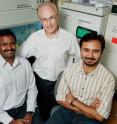Team finds link between stomach-cancer bug and cancer-promoting factor
Researchers report that Helicobacter pylori, the only bacterium known to survive in the harsh environment of the human stomach, directly activates an enzyme in host cells that has been associated with several types of cancer, including gastric cancer. Chronic infection with H. pylori is a well-documented risk factor for several forms of gastric cancer, but researchers have not yet determined the mechanisms by which specific bacterial factors contribute to cancer development. Nearly one-half of the world's population is infected with H. pylori, and gastric cancer is one of the leading causes of cancer-related death.
The new study, in Proceedings of the National Academy of Sciences, is the first to show that a factor produced by the bacterium directly activates poly(ADP-ribose) polymerase-1 (PARP-1), an enzyme found primarily in the nucleus of animal cells. PARP-1 is a regulator of the host's inflammatory response and host cell death, both of which are hallmarks of H. pylori infection.
PARP-1 is best known as a normal part of the cellular machinery that repairs damaged DNA. But in certain types of cancer this enzyme actually enhances tumor survival and undermines chemotherapies designed to damage DNA in cancer cells. A recent human clinical trial found that drugs that inhibited PARP-1 reduced tumor growth in breast-cancer patients with mutations in certain DNA-repair (BRCA-1 and BRCA-2) genes. BRCA-1 mutations also are associated with an increased risk of stomach cancer.
The new study tackled the most urgent health problem associated with H. pylori infection, said Steven Blanke, a University of Illinois professor in the department of microbiology and Institute for Genomic Biology and principal investigator on the study.
"What is it about sustained infection with H. pylori that leads in some cases to the development of stomach cancer?" he said.
Like other disease-causing bacteria, H. pylori have evolved to evade the body's defenses and even modify host proteins to help the bacteria survive.
Blanke and his graduate student Carlos Nossa previously had demonstrated that a protein factor released by H. pylori modifies an unidentified host protein in a manner consistent with an enzymatic reaction known as ADP-ribosylation. Other bacterial toxins, including cholera toxin and diphtheria toxin "ADP-ribosylate" host proteins in ways that enhance the survival or transmission of the bacteria that produce them.
"We were very excited about this finding, which we published in 2006," Blanke said. "We thought we had discovered a new toxin."
ADP-ribosylation can be tracked by incorporating a radio-isotope of phosphorous (32P) into a small molecule that is required for the reaction. During ADP-ribosylation, H. pylori transfers the 32P from the labeled molecule to a host protein, thereby tagging it with a radioactive fingerprint. Further analyses revealed that the radio-labeled host protein was PARP-1.
At this point, the team believed that the bacterium was ADP-ribosylating PARP-1. But when they genetically altered the functional regions of PARP-1, they completely blocked the H. pylori-dependent modification. Since PARP-1 also possesses poly-ADP-ribosylation enzymatic activity, which is necessary for its regulatory and DNA-repair function in cells, the team realized that something in the H. pylori arsenal was directly activating the PARP-1 enzymatic activity, rather than ADP-ribosylating it as they first suspected.
Additional studies validated that H. pylori indeed activates PARP-1 during infection of human gastric cells.
"These studies potentially provide a direct molecular link between H. pylori infection and the activation of a factor known to be involved in the survival of cancerous cells," Blanke said. "Although PARP-1 can potentially be activated indirectly as a host cell response to some infections, this is the first example of a bacterium that can activate PARP-1 directly, perhaps in this case as a mechanism for H. pylori to promote inflammation and/or the death of host cells during long-term infection."
The researchers are working to identify the bacterial factor that activates PARP-1, which would be a promising target for drugs to treat or prevent the problems associated with long-term infection with H. pylori, Blanke said.
Source: University of Illinois at Urbana-Champaign
Other sources
- Stomach-cancer bug linked to cancer-promoting factorfrom Science DailyThu, 7 Jan 2010, 6:28:16 UTC
- Bacteria linked to some cancersfrom UPIWed, 6 Jan 2010, 19:35:20 UTC
- Team finds link between stomach-cancer bug and cancer-promoting factorfrom PhysorgWed, 6 Jan 2010, 17:07:14 UTC
